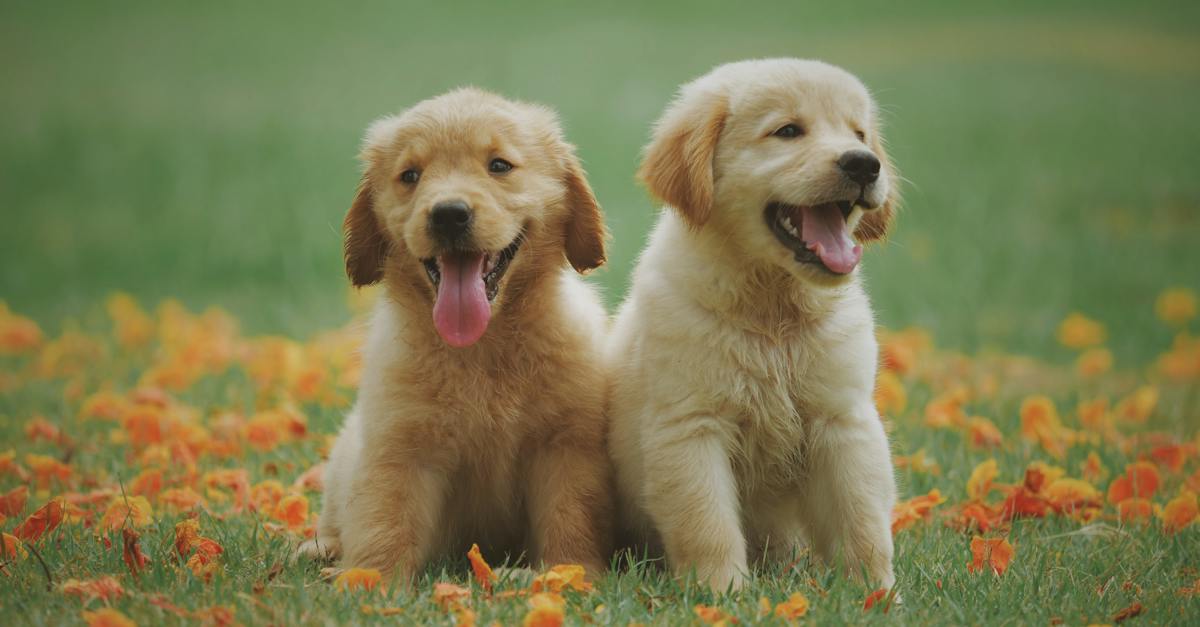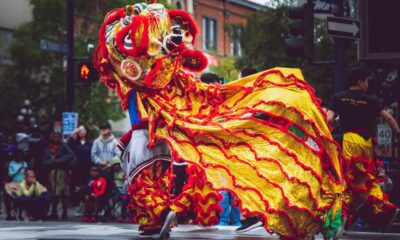Business
Introducing a Dog to a Puppy: Essential Tips for a Smooth Transition
Discover the best ways to introduce a new puppy to your resident dog with helpful tips and strategies in this article. From preparing your home and creating separate spaces for each dog to gradually introducing their scents and addressing negative behaviors, this guide covers everything you need to know for a successful introduction. With patience, supervision, and positive reinforcement, you can create a harmonious environment and prevent conflicts between your new puppy and resident dog. Seek professional help if needed, and remember to give each dog individual attention during the
Published
1 year agoon

So you’ve decided to bring a new puppy into your home, but you already have a resident dog. Introducing a new puppy to your dog can be an exciting but also a delicate process. It’s important to approach this introduction with care to ensure a smooth transition for both your furry friends. In this article, I’ll share some valuable tips and techniques on how to introduce your dog to a new puppy, helping them build a strong and harmonious relationship.
Bringing a new puppy into your home can be a joyful experience, but it’s crucial to remember that your resident dog may feel a mix of emotions, including excitement, curiosity, and even a bit of apprehension. By following a few simple steps, you can help ease their transition and establish a positive bond between your dog and the new puppy. In this article, I’ll guide you through the process of introducing your dog to a new puppy, from preparing your home to facilitating their first meeting. So let’s dive in and ensure a happy and harmonious introduction for your furry family members.
Prepare Your Home
Introducing a new puppy to your home is an exciting time, but it’s essential to make sure your space is well-prepared to make the transition as smooth as possible. Here are a few key steps to take in preparing your home for your new furry family member:
- Puppy-proofing your space: Just like with a baby, you’ll want to make sure your home is safe for your new puppy. This means securing loose wires, removing toxic plants, and keeping cleaning supplies out of reach. Be mindful of any potential hazards and make the necessary adjustments to keep your puppy safe and happy.
- Designating separate spaces: It’s important to give each dog their own space to retreat to when needed. This helps to avoid any potential conflicts and allows for a peaceful coexistence. Set up separate sleeping areas and feeding stations to help establish boundaries and ensure each dog has their own personal space.
- Ensuring proper training and resources: Well-behaved dogs are more likely to form positive relationships with each other. Make sure your resident dog and the new puppy are both trained in basic commands such as sit, stay, and come. Additionally, ensure that you have enough resources such as food bowls, toys, and bedding to accommodate both dogs.
- Gradual introduction of scents: Dogs rely heavily on their sense of smell, so it’s important to allow them to become familiar with each other’s scent before they meet face to face. Start by swapping blankets or toys between the two dogs so they can get accustomed to each other’s smells, creating a sense of familiarity.
- Creating neutral territory: When it’s time for the initial meeting, it’s best to do it in a neutral location that neither dog considers as their territory. This helps to reduce territorial behavior and the likelihood of aggression. Consider taking them for a walk in a nearby park or having them meet in a friend’s backyard.
Familiarize Your Dog with the New Puppy’s Scent
Introducing a new puppy to your resident dog can be a delicate process. It’s essential to ensure a smooth transition by taking certain steps to familiarize your dog with the new puppy’s scent. This introduction of scents will help reduce any potential anxiety or territorial behavior from your dog.
Here are some simple yet effective ways to help your dog become familiar with the new puppy’s scent:
- Exchange bedding or blankets: One of the best ways to introduce scents is by exchanging bedding or blankets between the two dogs. Place the puppy’s bedding or blanket in your dog’s area and vice versa. This will allow them to get accustomed to each other’s scent in a safe and controlled manner.
- Rub items with the puppy’s scent: Take a cloth or towel and gently rub it over the puppy, focusing on areas with the strongest scent, such as the back of the neck or paws. Then, place the scented cloth near your dog’s bed or in their living area. This will help them associate the new scent with positive experiences and gradually accept the presence of the puppy.
- Use a shared toy or chew: Introducing a shared toy or chew can also be a great way to familiarize your dog with the puppy’s scent. Allow both dogs to interact with the same toy, as it will transfer scents between them. This can create a positive association and curiosity in your resident dog.
- Gradual introduction: Slowly introduce the dogs in controlled and supervised environments. Start with short, supervised interactions while keeping them on leashes or using baby gates to maintain a safe distance. This gradual introduction allows them to get a sense of each other’s presence without feeling overwhelmed.
Remember, it’s crucial to allow your resident dog to adjust to the new puppy at their own pace. Rushing the process can result in stress and potential behavioral problems. By familiarizing your dog with the new puppy’s scent, you’re creating a foundation for a harmonious introduction and a positive future together.
Stay tuned for the next section, which will cover the importance of a neutral territory for the initial meeting between your dog and the new puppy.
Create Separate Spaces for Your Dog and Puppy
When introducing a new puppy to your home, it’s important to create separate spaces for your resident dog and the new addition. This allows each dog to have their own safe and secure space where they can retreat to when needed. It also helps to prevent any potential conflicts or accidents that may arise during the initial stages of introduction. Here are some tips on how to create separate spaces for your dog and puppy:
- Designate different areas: Set up separate areas in your home for your dog and puppy. This could be different rooms or separate sections within the same room. Make sure each space is equipped with comfortable bedding, toys, and water bowls.
- Use baby gates or barriers: Installing baby gates or using barriers can be a great way to physically separate your dog and puppy while still allowing them to see and sniff each other. This helps to create a gradual introduction and allows both dogs to get used to each other’s presence without direct contact.
- Create a safe haven for your dog: If your resident dog is feeling overwhelmed or stressed by the presence of the new puppy, it’s important to provide them with a quiet and secure space where they can relax. This could be a crate or a designated room where the puppy is not allowed to enter. Make sure this space is comfortable and stocked with familiar items like their favorite toys or bedding.
- Supervise interactions: While it’s important to give each dog their own space, it’s equally important to gradually allow them to interact under your supervision. This can be done by gradually increasing the amount of time they spend together in controlled environments. Always monitor their interactions closely and be ready to intervene if needed.
Remember, the goal of creating separate spaces is to give each dog their own time and space to adjust to the new dynamic. Let them set the pace for their interactions and never rush the process. In the next section, we’ll discuss the importance of a neutral territory for the initial meeting between the dogs.
Gradual Introduction through Scent
When introducing a new puppy to a resident dog, it’s important to allow them to become familiar with each other’s scents. This gradual introduction helps the dogs feel more comfortable and less anxious when they finally meet face-to-face. Here are some effective ways to familiarize your resident dog with the new puppy’s scent:
- Exchange bedding or blankets: Swap out bedding or blankets between the resident dog and the new puppy. This allows them to become accustomed to each other’s smell in a non-threatening way.
- Rub items with the puppy’s scent: Take a cloth or towel and rub it on the new puppy, focusing on areas with strong scent glands like the neck, ears, and paws. Then, rub the same cloth on your resident dog. This method helps transfer the puppy’s scent to the resident dog, further acclimating them to the new arrival.
- Use a shared toy or chew: Another way to introduce the puppy’s scent is by using a toy or chew that the new puppy has played with. Allow the resident dog to smell and interact with the toy, associating the scent with a positive experience. This can help ease any potential tension during their first meeting.
- Gradually introduce in controlled environments: Once the dogs are familiar with each other’s scents, you can start introducing them in controlled environments. Begin by allowing them to see each other through a baby gate or a screen door. This allows for visual contact while providing a barrier for safety.
Remember, the key to a successful introduction is to go at the resident dog’s pace. Allow them to adjust to the new scent and gradually increase their exposure to each other. Rushing the process can lead to stress and potential conflicts between the dogs.
In addition to familiarizing the dogs with each other’s scents, it’s also important to create separate spaces for the resident dog and the new puppy. This helps both dogs feel secure and have their own private areas. In the next section, we’ll discuss the importance of a neutral territory for the initial meeting between the dogs.
First Face-to-Face Meeting
When the time comes for the first face-to-face meeting between your resident dog and the new puppy, it’s important to approach it with caution and patience. This initial interaction can set the tone for their future relationship, so it’s crucial to create a positive and controlled environment. Here are a few key steps to consider for the first meeting:
- Choose a Neutral Territory: Selecting a neutral territory, such as a park or a friend’s backyard, can help reduce territorial behavior. Both dogs should feel comfortable and relaxed in this neutral space, which helps to prevent any potential conflicts.
- Keep the Dogs on Leashes: For added safety and control, it’s important to keep both dogs on separate leashes during the first meeting. This allows you to intervene quickly if necessary and helps prevent any unwanted behaviors.
- Introduce Gradually: Start by allowing the dogs to see each other from a distance. Observe their body language closely for signs of tension or aggression. If they appear calm and relaxed, you can slowly move them closer together, but always keeping a safe distance.
- Positive Reinforcement: During the meeting, make sure to reward both dogs with treats and praises for calm and friendly behavior. By associating the meeting with positive experiences, they are more likely to develop a positive association with each other.
- Monitor Body Language: As the dogs get closer, pay close attention to their body language. Signs of wagging tails, relaxed postures, and playful behavior are positive indicators. On the other hand, signs of raised hackles, stiff bodies, growling, or lunging should be taken as signs of potential aggression, and the meeting should be halted.
Remember, the first face-to-face meeting is just the beginning of the integration process. It’s important to continue with controlled and supervised interactions between the two dogs, gradually increasing their time together. Additionally, be sure to maintain separate spaces for each dog to retreat to, ensuring they both have a sense of security and their own personal space.
Next, we will discuss the importance of ongoing training during the integration process.
Supervise and Observe Their Interactions
When introducing a new puppy to a resident dog, it’s important to supervise and observe their interactions closely. This allows you to assess their behavior and ensure that the introduction is going smoothly. Here are some tips for supervising and observing their interactions:
- Stay calm and relaxed: Dogs can pick up on our emotions, so it’s important to remain calm and relaxed during the introductions. This helps create a positive environment for both dogs and reduces the chances of any tension or aggression.
- Keep them on a leash: During the initial interactions, it’s a good idea to keep both the new puppy and the resident dog on a leash. This provides you with more control and allows you to step in if needed. It also prevents any potential chasing or rough play that could escalate into a negative interaction.
- Watch their body language: Pay close attention to the body language of both dogs. Signs of stress or discomfort can include stiff body posture, raised hackles, growling, or excessive panting. On the other hand, relaxed body language, wagging tails, and play bows indicate that they are comfortable with each other.
- Intervene when necessary: If you notice any signs of aggression or tension between the dogs, it’s important to intervene immediately. Use a firm but calm voice to distract them, redirect their attention, or separate them if needed. Remember, safety is the top priority for both dogs.
- Reward positive interactions: When the dogs are behaving well and showing positive interactions, be sure to reward them. This can be done with treats, praise, or a favorite toy. Positive reinforcement helps reinforce good behavior and encourages them to continue getting along.
Remember, introducing a new puppy to a resident dog is a gradual process that requires time, patience, and careful supervision. It’s important to allow both dogs to adjust at their own pace and not rush the process. By supervising and observing their interactions, you can ensure a smoother and more successful introduction between your furry family members.
Establish a Routine and Provide Individual Attention
Introducing a new puppy to a resident dog is not just about physical space and training. It’s also important to establish a routine and provide individual attention to both dogs. This will help them adjust to the new dynamic and ensure that they feel valued and secure in their place within the family. Here are some tips to help you create a routine and provide individual attention to each dog:
- Schedule regular feeding times: Dogs thrive on routine, so it’s important to establish a consistent feeding schedule for both dogs. This will not only help with their potty training but also create a predictable environment that they can rely on. Make sure to separate the dogs during meal times, either by using separate rooms or crates, to avoid any tension or competition over food.
- Allocate separate playtime: While it’s great for the dogs to play and interact with each other, it’s equally important to give them individual playtime. This will allow them to bond with you and strengthen their individual relationship with you. Set aside dedicated play sessions for each dog, where you can engage in activities that they enjoy. It could be playing fetch, going for a walk, or simply spending some quality one-on-one time with them.
- Offer separate training sessions: Training is crucial for both dogs, especially during the introduction phase. While you can certainly train them together on basic commands, it’s also essential to provide separate training sessions for specific needs and abilities. This will help address any individual challenges or behavioral issues that may arise. Remember to use positive reinforcement techniques such as treats and praise to motivate and reward both dogs for their efforts.
- Create individual resting areas: Just like humans, dogs need their own personal space to relax and unwind. Provide separate beds or crates for each dog so that they can have a quiet and comfortable place to retreat to when they need some alone time. This will also help prevent any potential resource guarding or territorial behavior.
Remember, establishing a routine and providing individual attention to each dog is crucial for a smooth and successful introduction. It helps them feel secure, valued, and allows them to adjust at their own pace. By creating a balanced and nurturing environment, you are setting the foundation for a harmonious relationship between your new puppy and resident dog.
Address Any Negative Behaviors
When introducing a new puppy to a home with a resident dog, it’s important to address any negative behaviors that may arise from either dog. This will help create a harmonious environment and prevent any potential conflicts or issues down the line. Here are a few tips on how to address these behaviors effectively:
1. Monitor and intervene: Keep a close eye on the dogs’ interactions and be prepared to intervene if any negative behavior occurs. This could include growling, snapping, or aggressive body language. By monitoring their interactions, you can address these behaviors early on and correct them in a timely manner.
2. Use positive reinforcement: Instead of just focusing on correcting negative behaviors, it’s important to reward positive behavior as well. This can be done through treats, praise, or affection. By reinforcing positive behaviors, such as calmness or appropriate play, you’ll encourage your dogs to continue displaying these behaviors and discourage negative ones.
3. Seek professional help if needed: If you’re struggling to address negative behaviors on your own, it may be beneficial to seek the help of a professional dog trainer or behaviorist. They can provide expert guidance and tailor a training plan that specifically addresses the needs of your dogs. Remember, it’s always better to seek help early on to prevent issues from escalating.
4. Provide individual attention: Sometimes, negative behaviors can arise due to a lack of individual attention. Both the new puppy and the resident dog should receive one-on-one time with you. This can include separate play sessions, training sessions, or simply spending quality time together. By providing individual attention, you show your dogs that they are valued and loved, which can help address negative behaviors stemming from jealousy or insecurity.
Remember, addressing negative behaviors takes time and patience. Be consistent with your training and remain calm and assertive. With proper attention and intervention, you can help your dogs adjust to the new dynamic and establish a positive relationship with each other.
Patience is Key
Introducing a new puppy to a resident dog can be an exciting but also challenging experience. It’s important to remember that patience is key during this process. Here are a few things to keep in mind:
1. Give them time to adjust: Dogs are creatures of habit, and introducing a new puppy into their routine can disrupt their sense of security. It’s crucial to give both dogs time to adjust to the new dynamic. Don’t rush the process and allow them to get accustomed to each other at their own pace.
2. Supervise their interactions: When the dogs are together, it’s essential to closely supervise their interactions. This will allow you to intervene if any tension arises and prevent any negative incidents from occurring. Keep a close eye on their body language and separate them if necessary.
3. Use positive reinforcement: Positive reinforcement is a powerful tool when it comes to training dogs. When the dogs exhibit good behavior towards each other, reinforce it with praise or treats. This helps create a positive association and encourages them to continue to behave well around each other.
4. Seek professional help if needed: Sometimes, despite our best efforts, dogs may not get along. If you’re having difficulties introducing your resident dog to the new puppy, don’t hesitate to seek professional help. A professional dog trainer or behaviorist can assess the situation and provide guidance on how to manage the situation effectively.
5. Provide individual attention: While introducing a new puppy to your home, it’s crucial to ensure that your resident dog still receives plenty of individual attention. This will help prevent any feelings of jealousy or neglect and reaffirm their place in the family. Set aside quality time for bonding and play with each dog separately.
Remember, introducing a new puppy to a resident dog requires time and patience. By following these tips and being mindful of both dogs’ needs, you can help create a harmonious environment where they can thrive together. Stay positive and consistent, and soon enough, they’ll develop a strong bond that will last a lifetime.
Conclusion
Introducing a new puppy to a resident dog can be a challenging process, but with the right preparation and approach, it can also be a rewarding experience. By following the tips and strategies outlined in this article, you can create a harmonious environment for both dogs and prevent any conflicts or issues from arising.
Remember the importance of preparing your home for the new puppy and creating separate spaces for each dog. Gradually introduce them to each other’s scents and provide proper training and resources to set them up for success. Address any negative behaviors that may arise from either dog and use positive reinforcement to encourage good behavior.
During the introduction process, it’s crucial to be patient and give the dogs time to adjust. Supervise their interactions and provide individual attention to each dog. If needed, don’t hesitate to seek professional help.
By following these guidelines, you can ensure a smooth and successful introduction of your new puppy to your resident dog, fostering a strong bond between them and creating a harmonious household for everyone involved.
Frequently Asked Questions
Q: How can I introduce a new puppy to a home with a resident dog?
A: Prepare your home by creating separate spaces for each dog. Gradually introduce them to each other’s scents. Provide proper training and resources. Address any negative behaviors that may arise. Monitor and intervene in negative interactions. Use positive reinforcement to encourage good behavior. Seek professional help if needed. Give the dogs time to adjust and provide individual attention to each dog.
Q: What should I do if my dogs have negative interactions?
A: Monitor their interactions closely and intervene if necessary. Use positive reinforcement to encourage good behavior. Seek professional help if needed. Provide individual attention to each dog.
Q: How do I create a harmonious environment between the new puppy and resident dog?
A: Patience is key. Give the dogs time to adjust to each other. Supervise their interactions. Use positive reinforcement to encourage good behavior. Seek professional help if needed. Provide individual attention to each dog.
With over a decade of experience in the tech industry, Priya Sharma is a seasoned software engineer and tech blogger. She holds a Bachelor's degree in Computer Science from the Indian Institute of Technology (IIT) and has been a key contributor to cutting-edge projects in artificial intelligence and software development.

You may like
Mobility Scooter


Sideways Market: Navigating the Fluctuating Trends
Understanding Market Volatility Market volatility refers to the degree of variability in the price of a financial instrument within a...


Enhance Your iPhone with Adorable Cute Wallpapers
Looking to jazz up your iPhone screen with some cuteness? Discover the impact of adorable wallpapers on your device's look...


Glow Berry Prime: The Science Behind its Skincare Revival
Discover the transformative power of Glow Berry Prime in skincare with its potent blend of 20% Vitamin C, 2% Hyaluronic...


Glov Beauty: Eco-Friendly Products Review | Glov Beauty Reviews
Discover Glov Beauty's eco-friendly products like the Glov On-The-Go set with 500+ uses and the gentle exfoliation offered by the...


Unlocking Drake’s FPS Lyrics: How Gaming Influences His Music
Discover how Drake's lyrics in the first-person shooter-inspired track "War" reflect the influence of FPS games on his music. With...


Defeating a Fire-Breathing Dragon: Strategies for Mage Survival
Prepare yourself for an intense battle as we explore how to face a dragon capable of reaching temperatures over 2000°F....


Exploring Student Life at Glitties Eckerd College
Discover the dynamic student experience at Glitties Eckerd College with a plethora of club options, competitive sports, and community service...


Discover Success Stories with Money6x Real Estate Strategy
Discover the lucrative world of real estate investing with Money6x strategy! Uncover real-life success stories of investors achieving impressive 8-12%...


Get an Inside Look at Julion Alvarez’s 2024 USA Tour
Discover the meticulous planning behind Julion Alvarez's 2024 USA tour! Dive into the world of setlist curation, choreography design, and...


Enhancing Connections through Diversity & Active Listening
Learn how treating peers with empathy and actively listening can enhance relationships and boost innovation. The article emphasizes the significance...